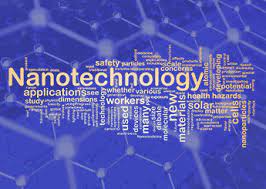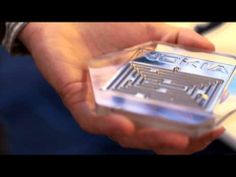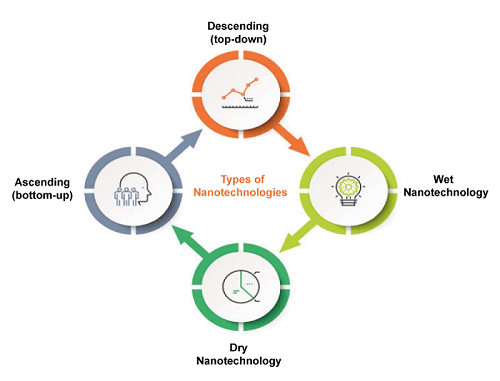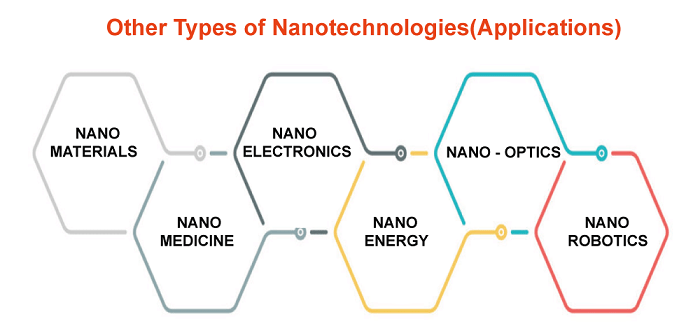Nanotechnology DefinitionNanotechnology is the study, manipulation, and fusion of matter at the molecular and atomic levels. Nanotechnology includes science, medical science, engineering, computer science, and robotic systems at this scale, termed the nanoscale. 
Nanotechnology can potentially create new, faster computer types, more effective power sources, and life-saving clinical treatments. Some potential drawbacks include economic disruption and potential risks to safety, privacy, health, and the environment. NanotechnologyBuilding 'things,' or more specifically, materials and devices, on the scale of molecules and atoms, is the focus of the study and innovation sector known as nanotechnology. A nanometer is one billionth of a meter or 10 times the diameter of a hydrogen atom. An average human hair measures 80,000 nanometers in diameter. The standard physics and chemistry laws are no longer valid at such scales. 
For example, there can be significant differences between materials' properties at the nanoscale and macroscale regarding their color, strength, conductivity, and reactivity. Carbon "nanotubes" are six times lighter and one hundred times stronger than steel. What Can Nanotechnology Do?Nanotechnology is praised as having the ability to improve energy efficiency, aid in environmental cleanup, and address significant health issues. It is said to be able to cut expenses while drastically increasing manufacturing output. According to promoters of nanotechnology, products will be more functional while being smaller, cheaper, and lighter and will take less energy and raw resources to produce. Nanotechnology HistoryRenowned physicist Richard Feynman introduced the concepts that would ultimately give rise to nanotechnology in 1959. He discussed the possibility of synthesis by the actual manipulation of atoms. The term "nanotechnology" was originally used by Norio Taniguchi in 1974, although it was not commonly used at the period. The term "nanotechnology" was first used by K. Eric Drexler in his 1986 book Engines of Creation: The Coming Era of Nanotechnology, which also promoted the notion of a nanoscale "assembler" capable of building copies of itself and other objects of arbitrary complexity with atomic accuracy. Importance of NanotechnologySoon, it is hoped that developments in nanotechnology will provide useful research instruments and medically useful gadgets. According to the National Nanotechnology Initiative, the pharmaceutical sector will create new commercial uses for enhanced drug delivery systems, innovative therapies, and in vivo imaging. Other ongoing research objectives include nanoelectronic-based sensors and neuro-electronic interactions. In the speculative area of molecular nanotechnology, cell repair technology is anticipated to have the potential to revolutionize the medical industry further. Nanotechnology is intended to offer a new and improved method for identifying and treating cancer. Nanoscale devices can influence large biological molecules both outside and inside cancer cells. Nanotechnology provides a wide range of instruments because biological processes, such as those that result in cancer development, occur on a nanoscale at the surface of cells and within them. Types of NanotechnologyAccording to their method of operation (top-down or bottom-up) and the environment inside which they work (dry or wet), the various types of nanotechnology are categorized: 
There are other different types of nanotechnologies: 
Nanomaterials are substances that have undergone nanoscale engineering or manipulation, resulting in distinct properties or behavior in contrast to their conventional counterparts. Nanoparticles, quantum dots, and carbon nanotubes are a few examples of nanomaterials. For example, the extraordinary strength and conductivity of carbon nanotubes make them helpful in various applications, including electronics, battery storage, and material science. Little particles known as nanoparticles, which have at least 1 dimension on the nanometre scale, can be composed of a variety of substances, including metals, oxides, and polymers, and they have special qualities that make them useful in a variety of industries, including the medical, cosmetics, and environmental sectors. Little semiconductor particles known as quantum dots are useful in solar cells, displays, and imaging applications in medicine.
To produce electrical devices that are faster and more efficient, nanoelectronics uses small transistors and other electrical devices at the nanoscale. Nanoscale transistors and memory systems are two examples. These small transistors and elements allow relatively small, more energy-efficient electronic equipment to handle and store more records than traditional electronic equipment.
By manipulating light at the nanoscale, nano-optics enables the creation of new optical gadgets and technologies. Nano-optical fibers and nano-antennas are two examples. These tiny optical components can be used to develop optical technologies, including more effective medical imaging equipment and communication networks.
The utilization of nanotechnology in medicine is known as nanomedicine. It entails using small components and nanoscale medical equipment to detect and treat diseases. Targeted medication delivery methods and diagnostic nanoparticles are a few such examples. Nanoparticles are used in targeted medication delivery systems to deliver pharmaceuticals directly to target cells or tissues, minimizing side effects and boosting treatment effectiveness. Diagnostic nanoparticles are capable of high-resolution imaging of the human body's inner workings and early illness detection.
The use of nanotechnology in the field of energy is known as nanoenergy. It entails effective energy generation, storage, and utilization through microscopic nanoscale components and materials. Nanobatteries, nanofuel cells, and Nanosolar cells are a few examples. Smaller, lighter, and more effective than conventional devices, these small gadgets and materials may be utilized to produce solar cells, batteries, and fuel cells that are more effective.
The development of microscopic machines and robots that can function at the nanoscale is known as nano-robotics. Examples include nanorobots and molecular machines. These tiny machines and robots can even function within the human body to treat or diagnose ailments and perform duties like assembling or maintaining other smaller equipment. Advantages of NanotechnologyThe following are the main advantages that nanotechnology brings to the world:
Disadvantages of NanotechnologyAlthough there are numerous possible benefits of nanotechnology, there are also some potential disadvantages, such as:
Examples and Applications of NanotechnologyEvery industrial sector can benefit from the use of nanotechnology and nanomaterials. They are typically located in the following areas:
Carbon nanotubes are rapidly displacing silicon as the preferred material to create lighter, more conductive, and stronger quantum nanowires. The characteristics of graphene make it a great choice for creating flexible touchscreens.
A new semiconductor created by Kyoto University enables the creation of solar panels that can convert twice as much sunshine into power. Moreover, nanotechnology lowers prices, makes wind turbines that are more powerful and lighter, increases fuel economy, and, due to some nanocomponents' ability to insulate heat, can reduce energy consumption.
Certain nanomaterials' qualities make them perfect for enhancing early cancer or neurological disease diagnosis and treatment. They can specifically destroy cancer cells without endangering healthy cells. Moreover, some nanoparticles have been used to improve prescription items like sunscreen.
Several of its environmentally friendly applications include heavy metal nanofiltration systems, wastewater treatment with nanobubbles, and ion-based air purification. Nanocatalysts are also available to improve the effectiveness and reduce the pollution of chemical reactions.
In this area, nanocomposites and nanobiosensors could increase food production by reducing oxygen transfer in packed goods, enhancing mechanical and thermal resistance, and detecting the presence of pathogens in food.
Nanotechnology enables the creation of stronger, lighter, and more durable substances for sports equipment and motorcycle helmets and adaptive fabrics that are wrinkle- and stain-resistant. Difference between Nanoscience and NanotechnologyAlthough the subjects of nanotechnology and nanoscience are closely connected, they differ significantly. The study of phenomena and the modification of materials at the nanoscale scale is known as nanoscience. It entails understanding how systems and materials behave at the nanoscale and creating new strategies for managing and modifying these materials. This may involve researching electrical, optical, and magnetic characteristics. On the other hand, nanotechnology is the application of nanoscience to create new materials, systems, and devices with novel characteristics and capabilities. It entails using the skills and information acquired in nanoscience to develop new tools, goods, and technology. Applications in the areas of energy, electronics, materials science, and medicine can be included in nanotechnology. In essence (in short), nanoscience is the foundation of knowledge that supports our capacity to understand how materials behave at the nanoscale. In contrast, nanotechnology is applying this knowledge to develop new materials, systems, and devices. The Future of NanotechnologyFuture developments in nanotechnology have both positive and negative aspects. On the one hand, the industry is anticipated to expand on a global scale, propelled by, among other things, technological advancements, more government assistance, increased private investment, and rising consumer demand for smaller gadgets. Expanding the market, however, could be hampered by the threats that nanotechnology offers to the environment, human health, and safety, in addition to concerns about its commercialization.
Next TopicNucleus Definition
|
 For Videos Join Our Youtube Channel: Join Now
For Videos Join Our Youtube Channel: Join Now
Feedback
- Send your Feedback to [email protected]
Help Others, Please Share










